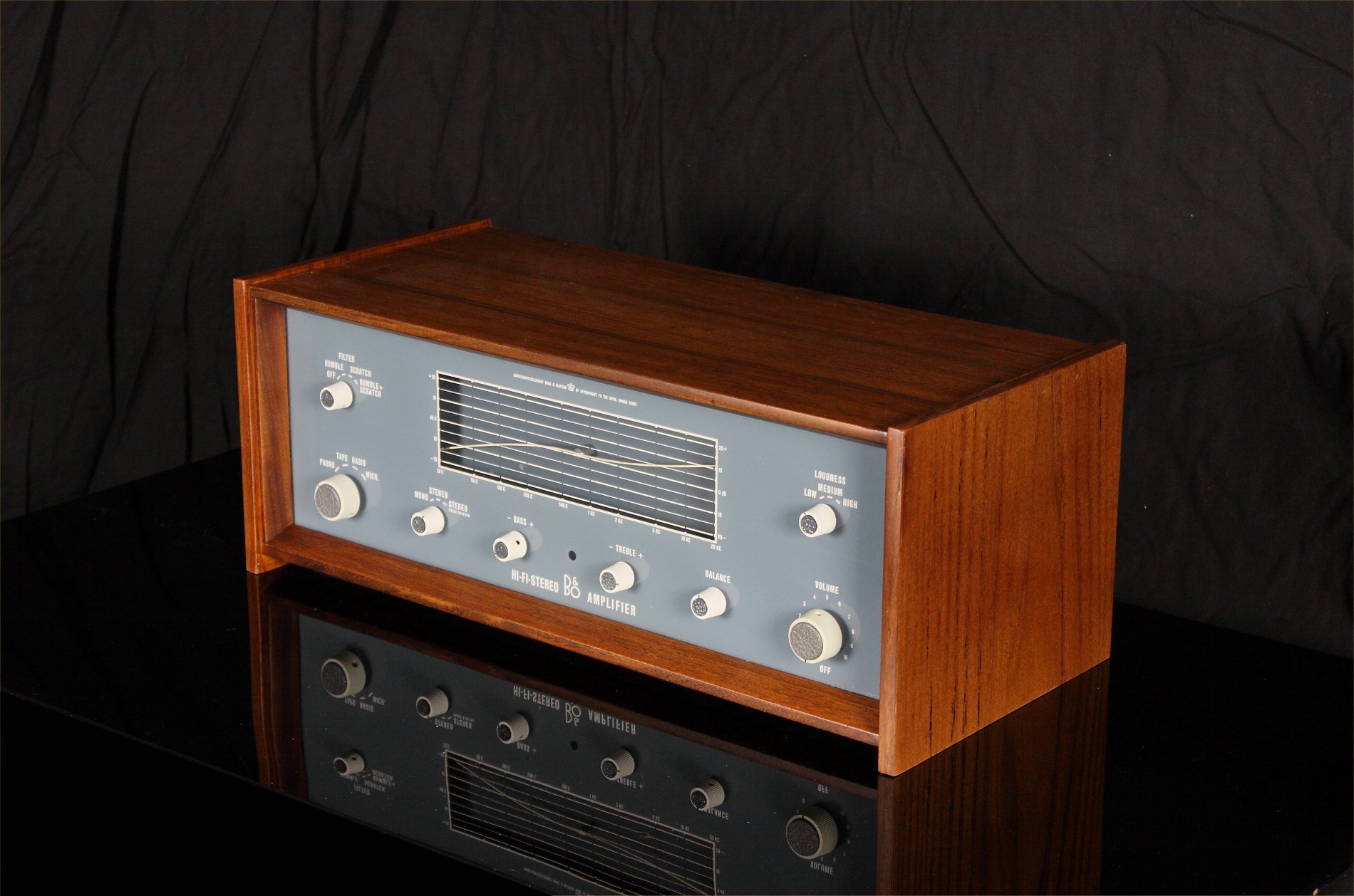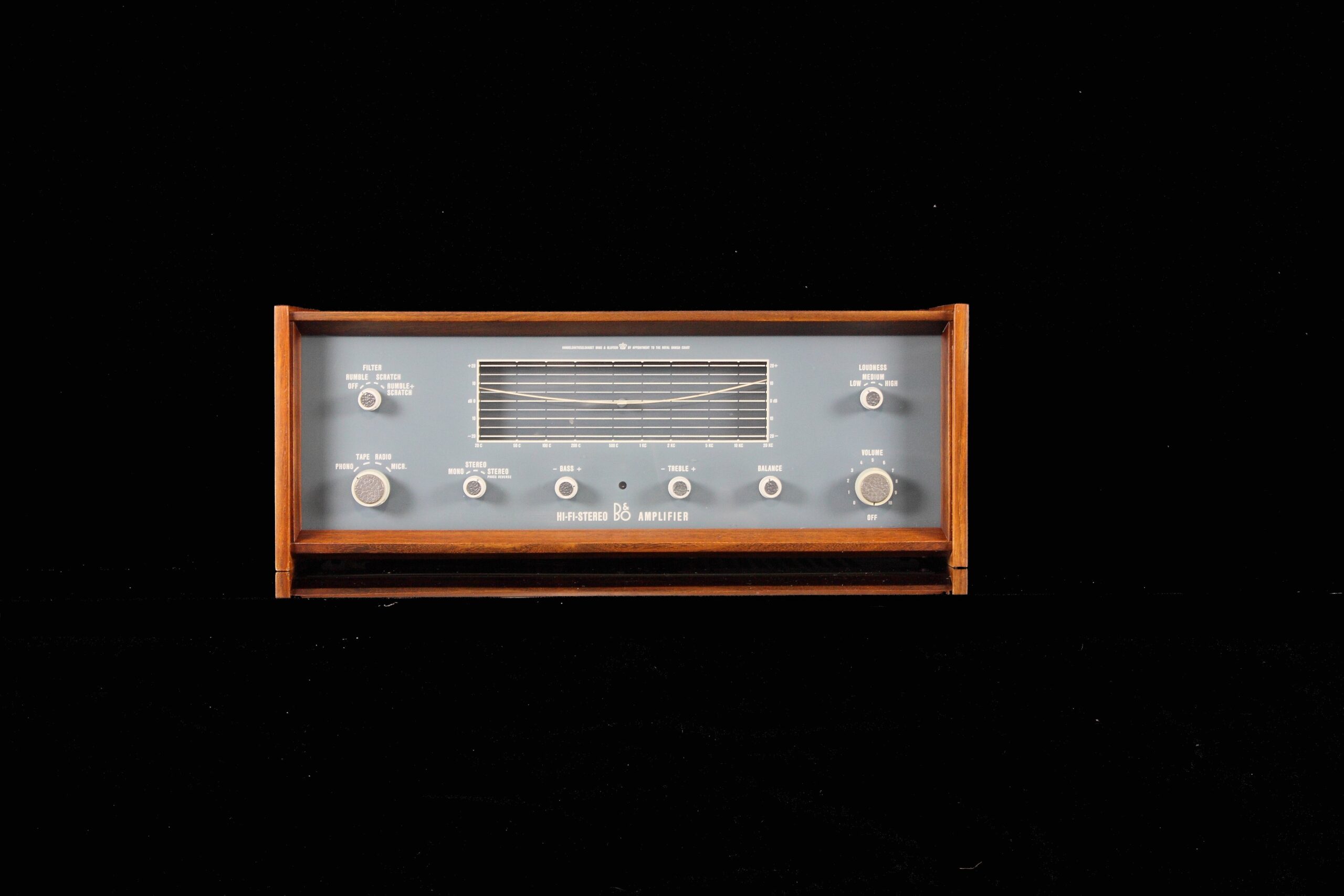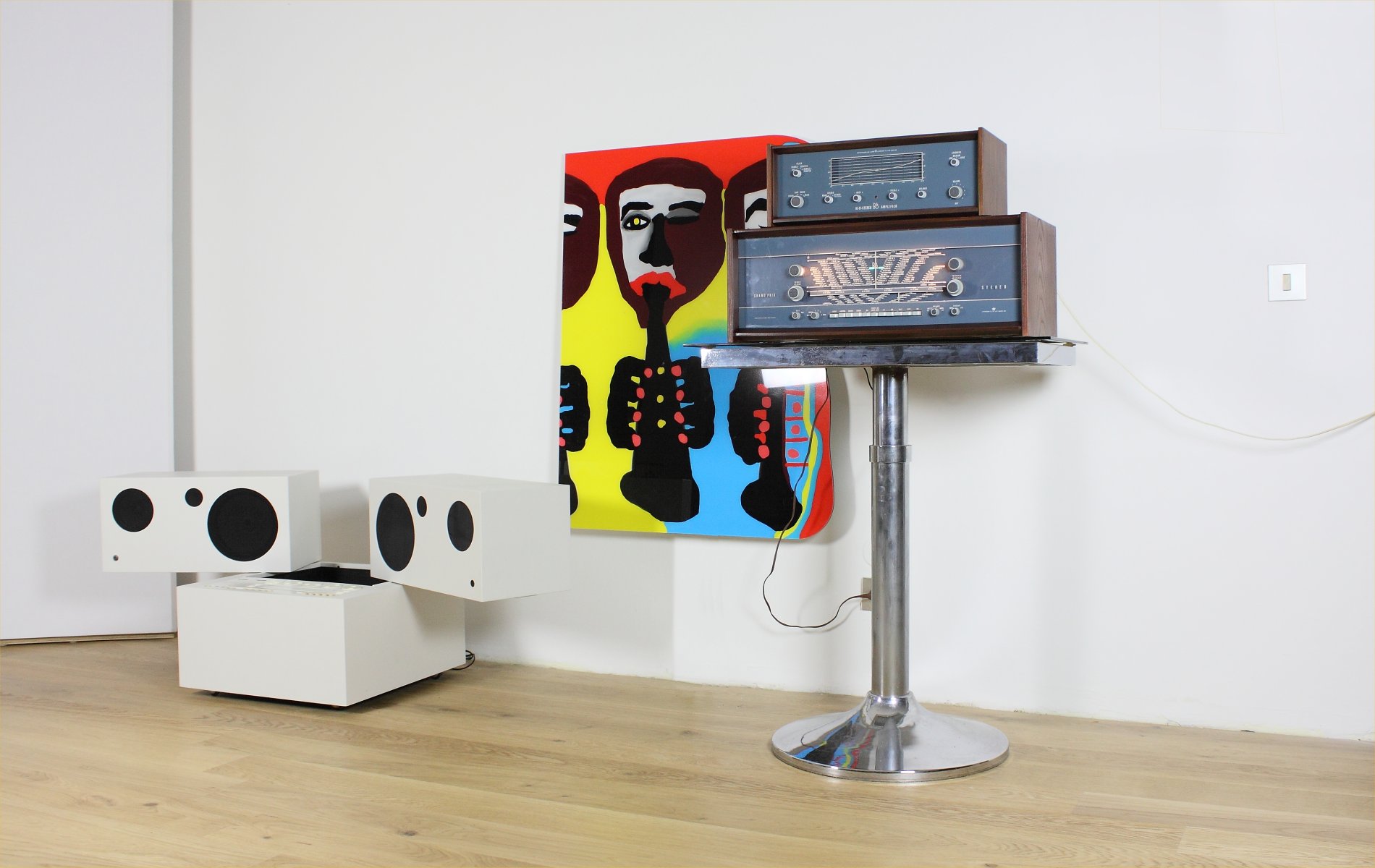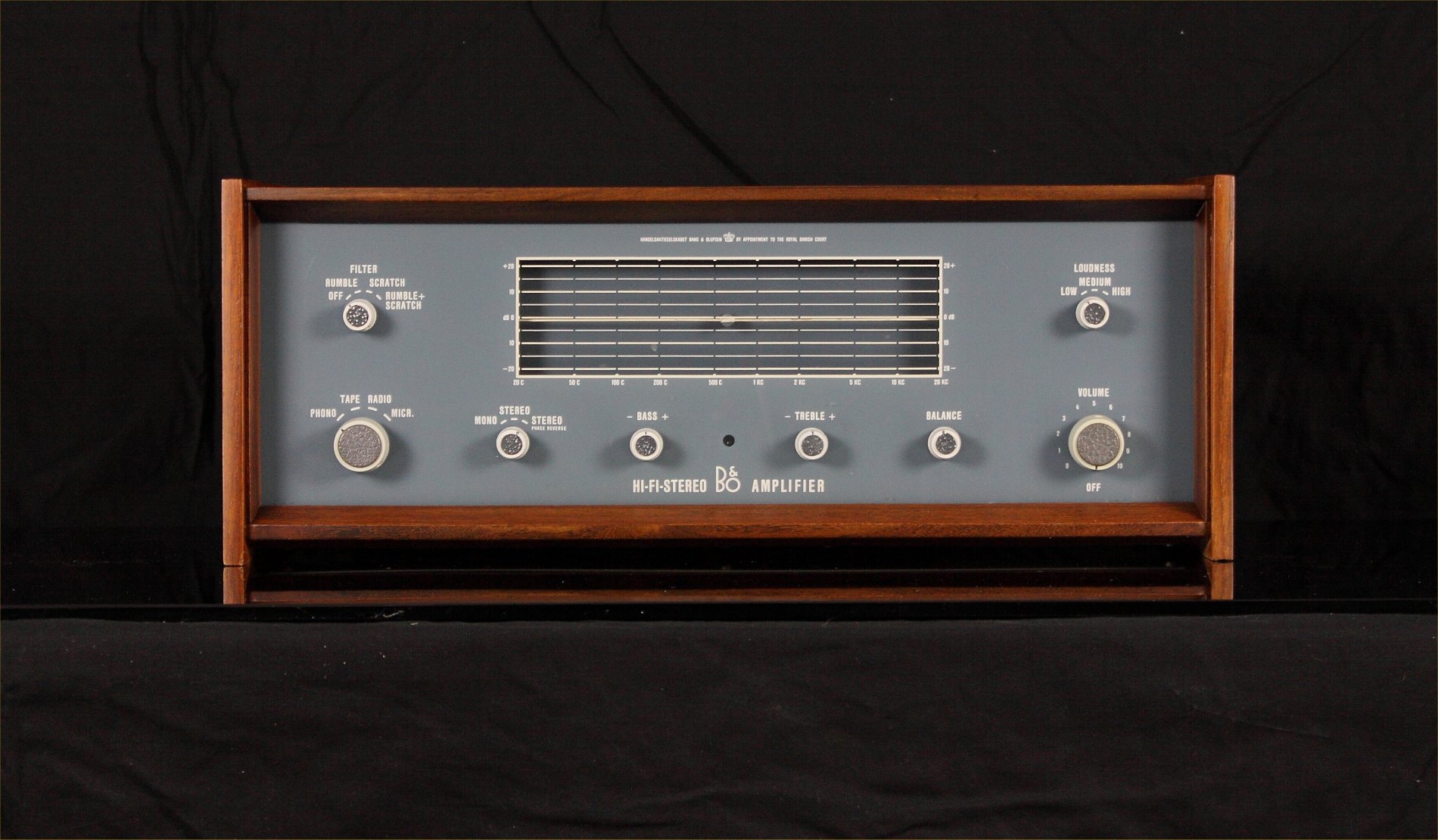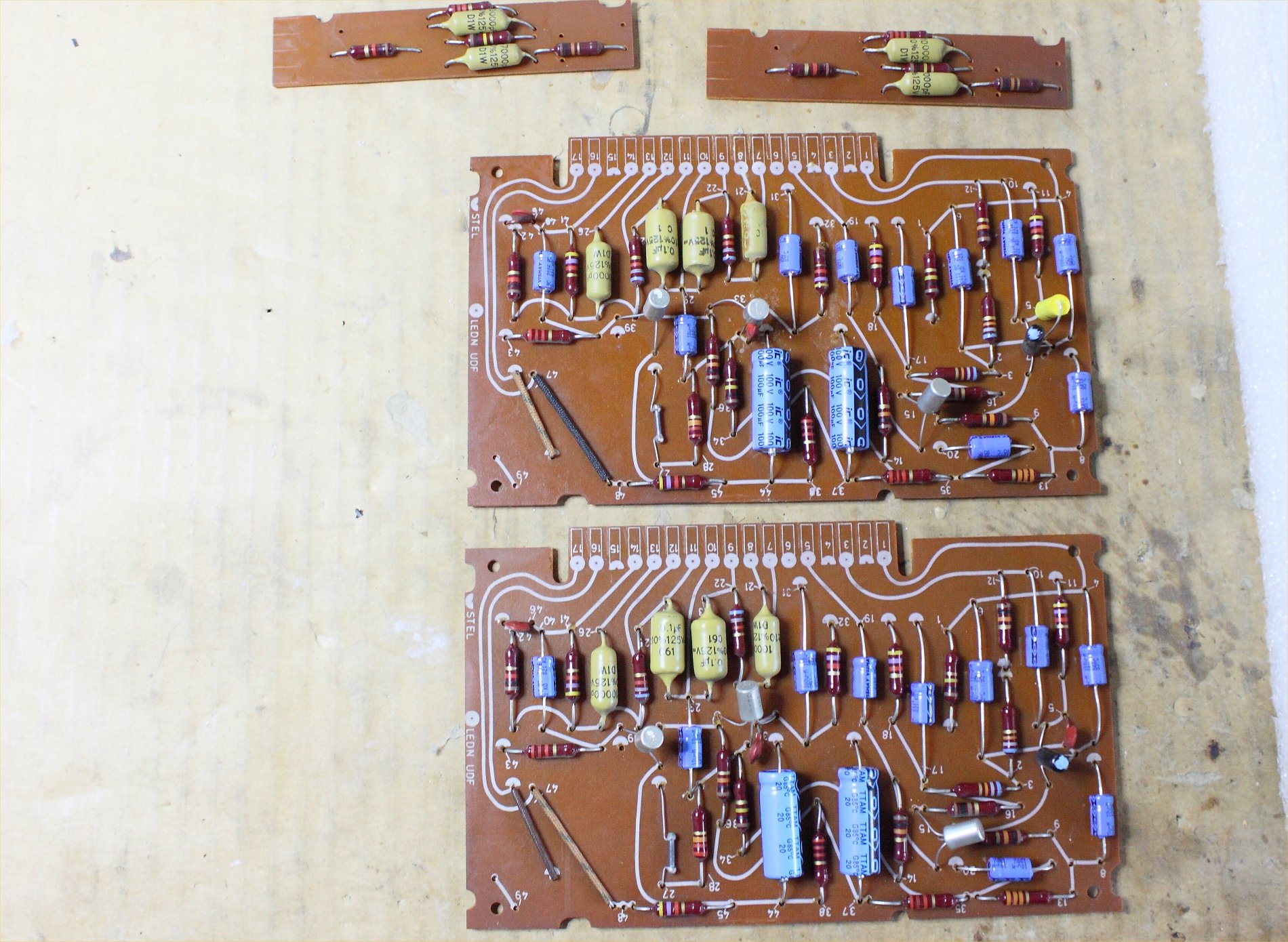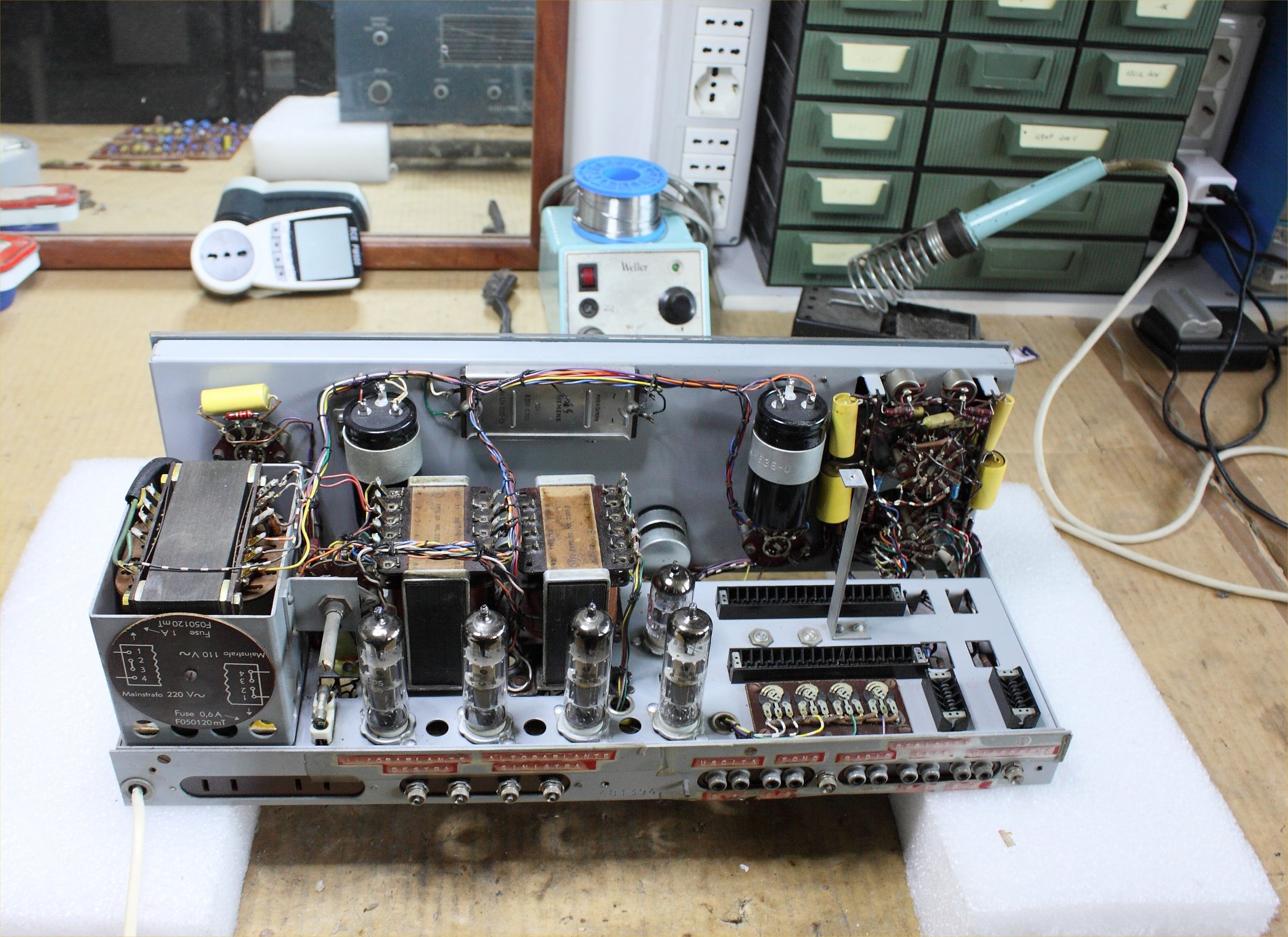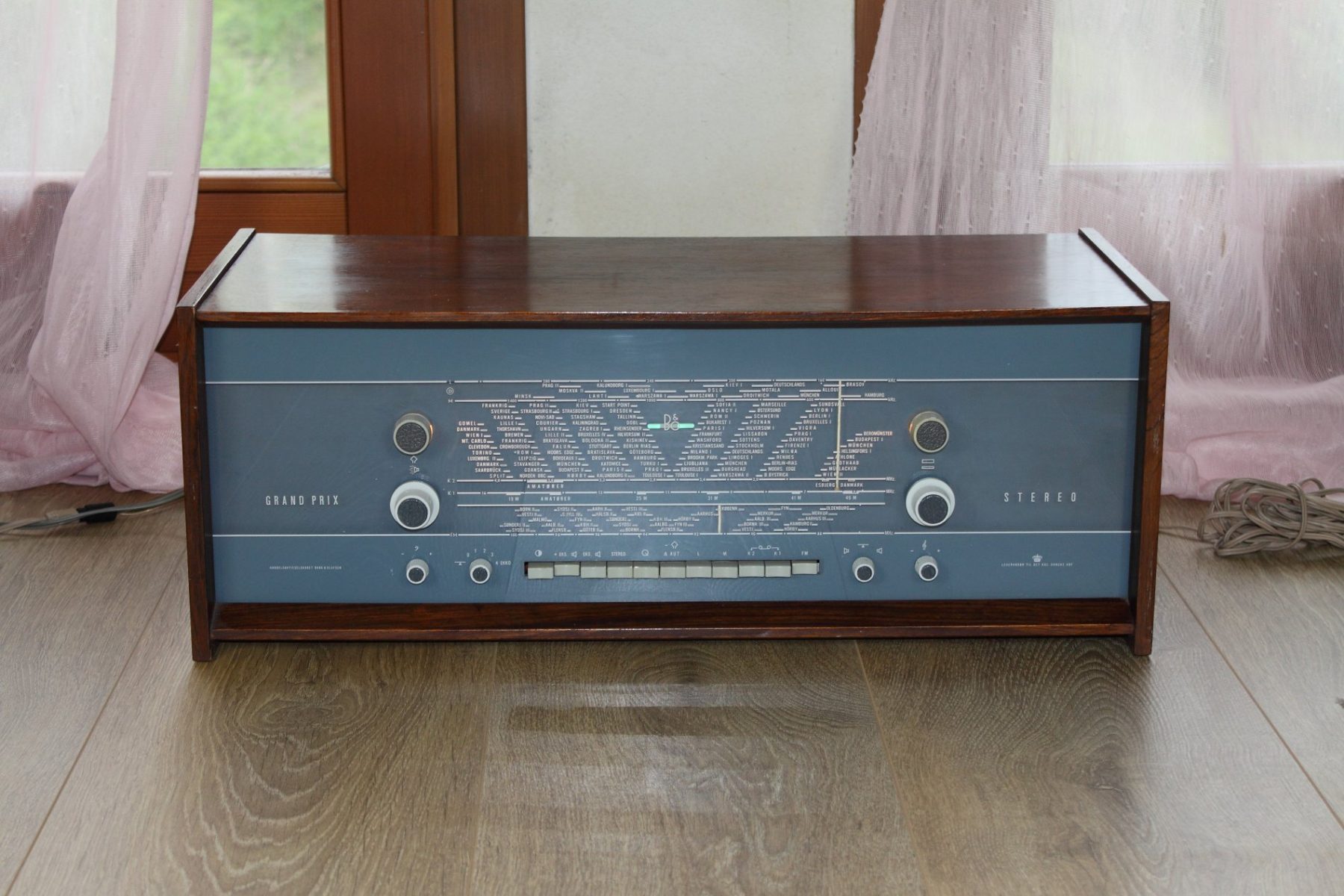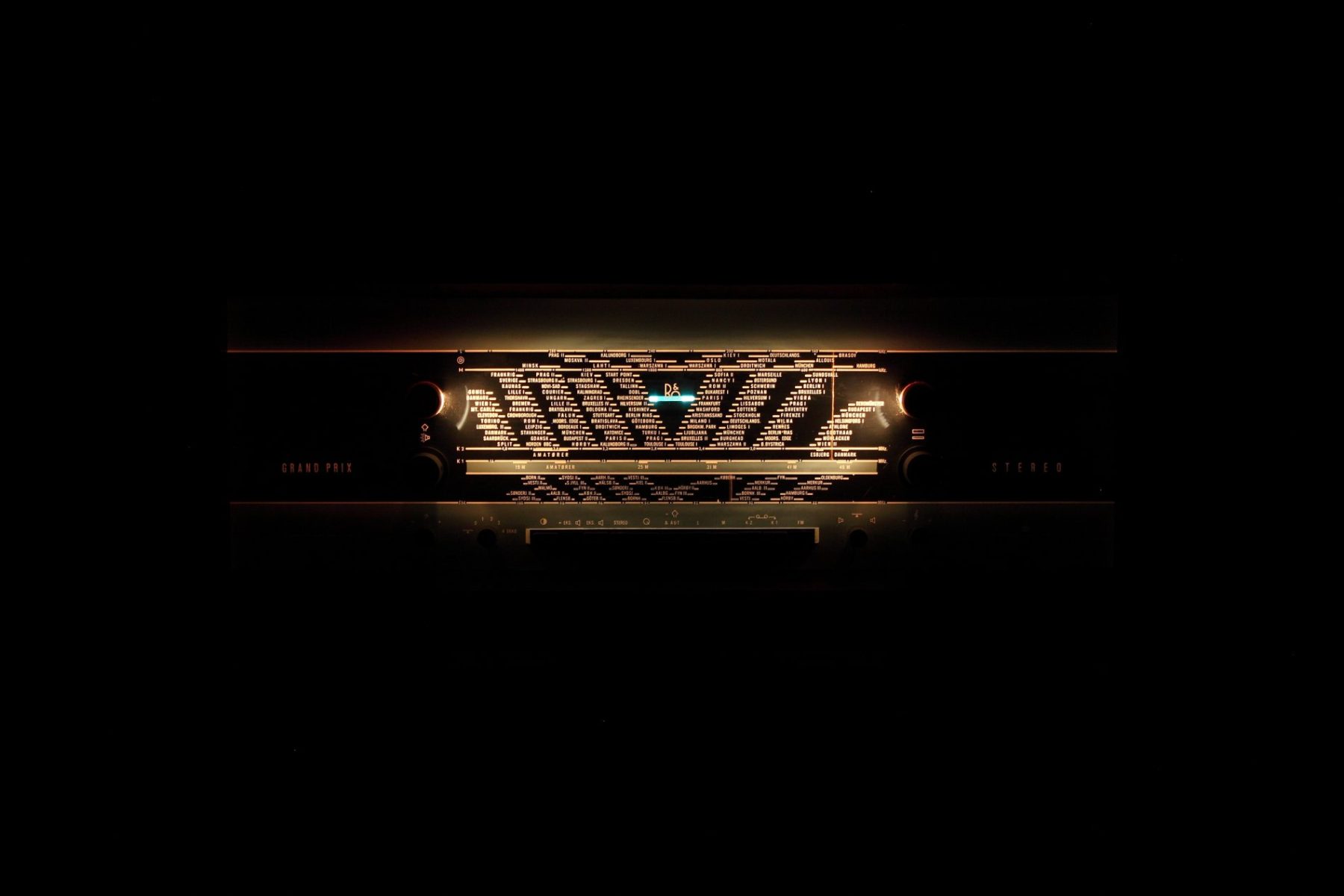 bang & olufsen - en
bang & olufsen - en
Bang & Olufsen – High Fidelity Stereo Amplifier 608…
- 2nd December 202128th May 2022
- by giovanni
Bang & Olufsen - High Fidelity Stereo Amplifier 608
The High Fidelity Stereo Amplifier 608 was produced from 1961 to 1964 and it's the first Hi-Fi stereophonic amplifier by Bang & Olufsen; that explains its great value, both historical and economic.
The second series had a dark gray front panel but no significant technical changes and together with the Grand Prix receiver it marks a groundbraking step for the Danish firm's design.
The inner set up is a masterful piece of work: cables are put in order and wrapped in a waxed twine binding to create a solid unique body. The power tubes’ polarisation is fixed and each of them has an accurate Bias' control by specific trimmers, as shown in the restoration's photos.
The circuit is very stable due to a 22pF capacitor parrallel connected to a 100 kOhm resistance avoid auto-swinging. The feedback rate is very low.
The power tubes’ set up is ultralinear.
The direct coupling (no capacitors) between the voltage amplifier anode ECC83 and one of the two tubes for the phase splitter is another device's distinctive trait.
A differential circuit realise the phase reversal, in this way a perfect half - waves' symmetry and a remarkable voltage's gain are achieved.
The tones control circuit is a Baxandall, making symmetrical regulation curves (keep scrolling for answer's curves pictures).
Each final stage (two in all) is made up of an ECL85 (so, in total, there are four ECL85). The ECL85 is velvety like ECL86 but more powerful, indeed the rated output is highed than the same series' receiver Grand Prix Moderne Stereo 608.
It's very appreciable the chance to switch right and left speakers phase: if they were connected without paying attention the exact phase can be restored thanks to a switch on the frontal panel. The result, with the speakers in phase, is substantial; voices and solo instruments are clearly distinguishable and the scene take shape.
Not by chance, B&O became the official supplier of the Danish royal house.
This device, designed in an extremely sophisticated way, does not disappoint the listener's expectations: at first a well-finished and sweet sound can be gathered but by turning the volume knob and loudness switch (below in this page) its strengh and intensity are revealed.
A refined design, the charm of an old fashioned and expansive object, a precise and powerful sound and, last but not least, a small number of models, are all features of this fantastic device.
Designer: Architect Ib Fabiansen (1928 – 2009)
Fabiansen started developing modular units for radios and televisions complementing each other with the house forniture and establishing a pleasant surrounding.
In 1958 he made some cardboard models and presented them to Bang & Olufsen management, that immediately approved its production. So he started sketching the Beolit series and other B&O devices, including Hi-Fi Amplifier 608.
In 1962 he designed Beocord Belcanto recorder, Horizont television and so on, until his last creation for B&O, the gramophone TV/radio Beovision 2000RG.
In the last years working for B&O, he cooperated with architecs Henning Moldenhawer an Jacob Jensen.
".. there was a time when it was far from a certainty that a radio from Bang and Olufsen was a study in good design..It was horrible, simply horrible” sayed back then Fabiansen.
Ten years later Jacob Jensen would become the company's chief designer.
To make the most of this device I chose four songs. The first one is “Una ragione di più” by Ornella Vanoni, a beautiful song with lyrics by Franco Califano, Ornella Vanoni and Luciano Beretta, music by Mino and Franco Reitano. Presented in 1969 on the tv show “Senza rete”, the song is about a woman questioning her relationship, and her hard choice between leaving her partner and trying to revive their love from ashes. Ornella's voice is warm, deep and with a great vocal range, which the B&O 608 conveys in all its richness.
The struggle of a love song counterpoints the struggle for exile and oppression is in the second song I propose. It's of an Angolan songwriter, José Adelino Barceló de Carvalho aka Bonga. The title of the song is “Mona Ki Ngi Xica” ad it was written in 1972, while Angola was under Portuguese rule and the author had to flee to the Netherlands because of his politics involvement to free his nation. The lyrics are in Kimbundu, an Angolan dialect. Here, too, a rough and peculiar voice is reproduced in its wholeness by the 608.
Going on with love sufferings (that's the mood of the day), the third track is about a young man and his love, not returned by the girl he loves. It's the well-known song “Say Say Say” by Paul McCartney and Michael Jackson, recorded in 1983 before their quarrel. It seems that McCartney was quite afraid of dancing together with Jackson in the song's videoclip (we can't blame him), but still a true friendship was born, until Jackson bought the Beatles' recording royalties for 47,5 million dollars, snatching them from McCartney and Yoko Ono.
The fourth and last track is Mahler's Symphony N. 5, written between 1901 and 1902. Its theme, sentimental and painful, turns away from the preceding four symphonies, which are about medieval german poetry. The mighty first movement is driven by trumpets and the vigorous orchestral cue does not scare the 608. It's important that the speakers are properly in order.


Ornella Vanoni - José Adelino Barceló de Carvalho (Bonga)
BLUETOOTH
Bluetooth receiver embed
MULTI PLATFORM CONNECTION
Each radio is equipped with a cable for connection to any digital device.
TUBESOUND IMPROVEMENT
- Bluetooth receiver embed - The unit is equipped with a BLUETOOTH receiver powered directly by the receiver power supply. This makes it possible to control the amplifier from any external digital device as an IPAD, a Smartphone, or a sophisticated multimedia station. So you can hear your preferred web station or your lossesless file without cables on the room. Wireless Receiver can be equipped upon requests.
- Multi Platform Connection - A customized adaptation cable to connect any digital device as Iphone, Smartphone, Laptop, CD Player etc. will be provided with this radio. This special cable suits the different impedances between the modern equipment and the receiver. Furthermore the two stereo channels flow into one without increasing the load to the input unit.


HISTORY
1925 - Two Danish engineers, Svend Olufsen and Peter Bang, start the production of radio equipment in the attic of the Olufsen family, in Struer.
1927 - The first device, called the “Eliminator” (as it allowed to eliminate the battery power and to connect the device directly to the power grid), is commercialized.
A production plant is built in Struer.
1929 - The "Five Lamper" model (five valves) is marketed and is a great success.
1938 - The beautiful Master 40 model arrives, which allows to memorize stations from the keyboard.
1939 - Beolit 39 is launched, the first radio with a bakelite cabinet. From this moment on, the prefix “Beo” will be used for the most prestigious products of the brand.
1941 - During the German occupation, B&O puts on the market the Grand Prix 42CH which has the characteristic of having a tambour door that covers the scala parlante when it is not used.
1945 - The B&O factory is completely destroyed.
1948 - After a rapid reconstruction of the factory, the production of the Grand Prix 48 CH mobile radio is started, the first high-fidelity radio of the Danish company.
60's - A revolution at B&O. The designer Ib Fabiensen designs the new line of devices, Hi-Fi Stereo Amplifier 608, Grand Prix 608 Moderne, Dirigent 609. Also the Beogram 42 turntable is commercialized. It is with these models that the legendary design of B&O devices begins.
70's - In the 60s and 70s, the devices that make B&O famous in the world are produced. The Beomaster 1200 and 3000, the Beogram 1200 and the Beogram 4002, the beautiful giradischi tangenziale. The devices are designed by Jacob Jensen.
80's - The evolution of design continues with the different Beocenter units and the Beogram cd players.
90's - The company decides to market its products through a network of its own exclusive stores. It expands its interests with the production of mobile phones and Mp3 players.
2008 – It suffers considerable losses and a staff reduction and in the following years it returns to devote itself exclusively to the production of High Fidelity devices.
2015 - B&O becomes a partner of HP.


MAIN FEATURES
Year of production: 1961-64
Power supply: 110-220 V - 75W
Loudspeakers: Screw Plugs for External 4-16 ohm loudspeakers
Output power: 15W each channel
Distortion: <0.5 % a 10W, <2 % a 15 W
Channel separation: - 50 dB
Noise level: - 60 dB
Frequency response: 20-20,000 Hz <1 dB
Min. input level:
Magnetic Pickup 2 mV, DIN 45547 RIIAA equalized
Piezo Pickup: 50 mV
Aux: 100 mV,
Microphone: 160 mV
Tuner: 50 mV
Measurements (LAP): 465 x 180 x 208 mm / 18.3 x 7 x 8.2 inch
Net weight: 10.5 kg / 23 lb 2 oz
5 Tubes: ECC83 ECL85 ECL85 ECL85 ECL85
8 Transistors: 2xAC107, 6xAC126(OC75)

Controllo toni
In these pictures we can see how much the tune's control system is efficient: in the ones above there's the controls' position in the amplifier, in the ones below the real response curve measured with Wandel&Goltermann WM-20 wobbulator. Measurament done on 4 ohm resistive load.
In the first two pictures on the left we can see the tunes in Flat position: the answer, from 20 to 20000 Hz, stays between ± 1 dB. Others pictures explain themselves.

LOUDNESS CONTROL
The device has a remarkable loudness control system. We know that our ears, listening at low volume, perceive better medium frequencies, losing the low and high ones. If low frequency sounds are emitted, medium frequencies are easily perceptible by human ear than low, very low and high ones. That's why, for these listening levels, manufacturers implemented automatic mechanism to amplificate low and high frequencies.
Today this control practice is seen as a forced sound's alteration and is not implemented in amplifiers. Sometimes is not inserted at all, but if it's stil present there's the possibility to exclude it with a knob on the front panel.
On B&O Hi-Fi Amplifier 608 there is a switch for low, medium, high, referring to the listening volume.
With the switch on LOW, loudness control (exalting low and high frequencies) applies at 10 Phon on the Fletcher – Munson curve; with this setting, sound level acheivable operating on volume knob is gentle and is suitable for listening at a low volume.
Putting the switch on MEDIUM, loudness control applies at 50 Phon; low and high frequencies are slightly exalted, you can get a higher sound level and it's good for listening at a medium volume.
With the switch on HIGH there's no more loudness control and response is linear on all frequencies but sound level you get operating on the knob is not maximum. Thanks to this setting you reach amplifier's full power and it's right for listening at its highest volume.



LOUDSPEAKERS
This stadio amplificatore is gifted with noticeable transparency and detail.
The coupling with high-efficiency loudspeakers with neutral tone is therefore very suitable to enjoy these peculiarities to the fullest.
The loudspeakers must be connected with banana plugs on the outputs, respectively:
Højre - Right channel
Venstre - Left channel
The Bang & Olufsen loudspeakers, designed to be coupled to the Grand Prix Moderne Stereo 608, were the Type S (left) and Type L (right) models.
The recordings I posted on this page were made with TRIO-KENWOOD KL333 loudspeakers. I chose these speakers for their efficiency and the very high cut-off frequency that makes them sound almost like full-range speaker.


Beginning from the left in the upper part, the first knob you meet is that of inserting the filters. The switch has 4 positions.
OFF - No filter is active - Linear response
RUMBLE - Very low frequencies are attenuated to avoid reproducing the mechanical noises of the turntable
SCRATCH - The high frequencies are attenuated to attenuate the defects of damaged discs when listening.
RUMBLE + SCRATCH - Both filters inserted
Attentions! The RUMBLE filter introduces a 45 degree phase shift at the cut-off frequency and both filters proportionally attenuate all the frequency band of the respective working range. Avoid using them if possible, better couple the amplifier to a good turntable and treat the records with care.
Below we find the INPUT SELECTOR
PHONO - Turntable with magnetic head
TAPE - Recorder / AUX
RADIO - Tuner / AUX
MICR - Microphone
Then we find the MONO / STEREO / PHASE REVERSE switch
This last position of the switch allows to invert the phase of one of the low impedance outputs (loudspeakers) to have all the movements of the cones in phase.
Still to the right the two tone controls LOW and HIGH. Above the tone controls is the display that indicates their position by highlighting the response curve of the amplifier.
The largest knob is the VOLUME knob with built-in ON / OFF switch. Turning the knob clockwise turns on the amplifier.
Above we see the 3-position LOUDNESS switch.

REAR SIDE
110V-220V voltage change
Switch Speaker Impedance 4 Ohm - 16 Ohm
OUTPUT
2 x additional US type mains voltage sockets (220-110V)
Screw connectors for left and right speakers
2 x line signal RCA sockets (e.g. for recording)
INPUT
2 x RCA plug - Pick-up
2 x RCA plug - TUNER/AUX
2 x RCA plug - TAPE RECORDER/AUX
2 x RCA plug - Microphone
THE USUAL AMAZING LAST IMAGE



